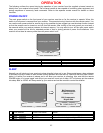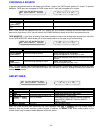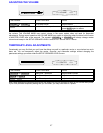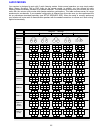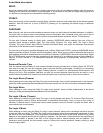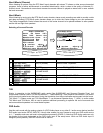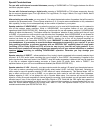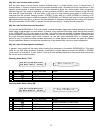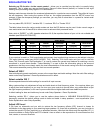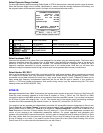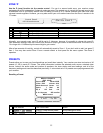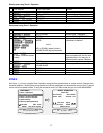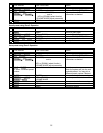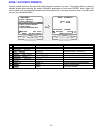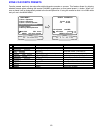
53
EQUALIZATION ‘EQ’
Selecting an EQ function via the remote control - allows you to override how the audio is currently being
processed. This is where you may set the Dynamic Range to either Normal (default) or Limited for late night
listening while processing Dolby Digital or DTS bit streams.
Settings made here are intended for occasional adjustments for a particular source material. They affect all inputs
but are temporary. After turning the system off and on, the original parameters from the SETUP menus are
restored. If there are temporary settings you use often, you may wish to store them in a preset for instant recall
See PRESETS.
You may select EQ, Off ‘EQ 0”, Variable ‘EQ 1’, Loudness ‘EQ 2’ or Theater ‘EQ 3’.
The table below shows the various audio modes and how the EQ feature may be used. Under normal usage a
user would select one of these EQs to either correct or enhance their processed audio.
Note, while in ‘DIRECT’ or ‘LtRt’ (speaker selections 8 & 9) the equalizer feature of your unit is not available and
disabled (see EQUALIZATION ‘EQ’).
Equalizer Audio Mode
EQ Name EQ # Mono Stereo Surround THX DVD Audio
Off
0 bypassed bypassed bypassed bypassed bypassed
Variable
1 Bass / Treble Bass / Treble Bass / Treble Bass / Treble bypassed
Loudness
2 fixed response fixed response fixed response fixed response bypassed
Theater
3 fixed response fixed response fixed response fixed response bypassed
If your receiver is used in a THX home theater environment, best results during movies may be realized using the
THX audio listening mode (see AUDIO MODES, THX). Selecting THX Audio mode sets your unit for use with
Home THX Cinema mode. Re-Equalization™ is used to restore the correct tonal balance for watching a movie
soundtrack in a small home theater. Timbre Matching™ is used to filter the information going to the surround
speakers so that they more closely match the tonal characteristics of the sound coming from the front speakers.
This ensures seamless panning from the front to surround speakers.
Select off ‘EQ 0’
Use to disable any preset equalization curves or the current bass and treble settings. Note the notch filter settings
made under Setup Speakers - Room Equalization are still in effect.
Select variable ‘EQ 1’
Allows separate bass and treble settings for use with all input sources.
Many systems allow only adjustment of bass and treble levels at fixed frequency points. Your receiver allows you
to adjust level and frequency so you may fine tune your tone controls to proved either very subtle effects at just
the right frequency extremes, or for more a pronounced effect at higher bass and lower treble frequencies.
A default setting for bass and treble may be set under Setup Speakers - Room Equalization.
Selecting variable ‘EQ 1’ allows you to use the options shown below in VARIABLE EQUALIZATION, and
temporarily override the default settings made to bass and treble in setup speakers - room equalization (See
Room Equalization under Setup Speakers).
Adjust LFE Level
If you have no subwoofer and you wish to reduce the low frequency effects (LFE) channel to lessen its
contribution to the bass going to your remaining large speakers. Or, even with a subwoofer, you may just wish to
reduce the overall LFE level, especially in an apartment situation. Note that this affects only the separate LFE (.1)
channel available on Dolby Digital and DTS material it has no effect on the reproduction of normal bass from the
front, center, or surround channels.



